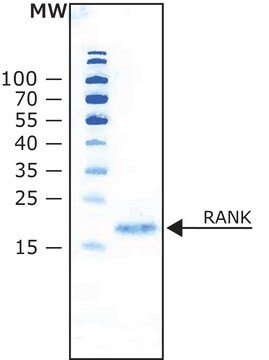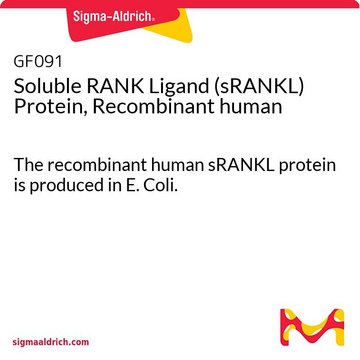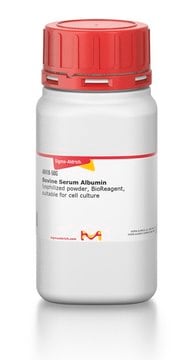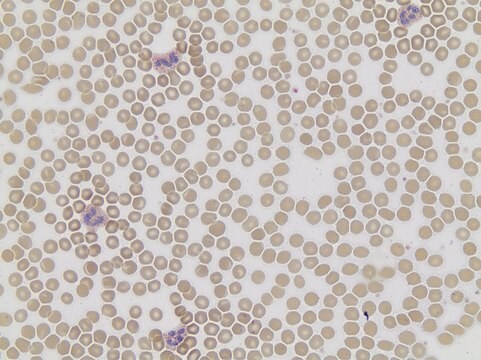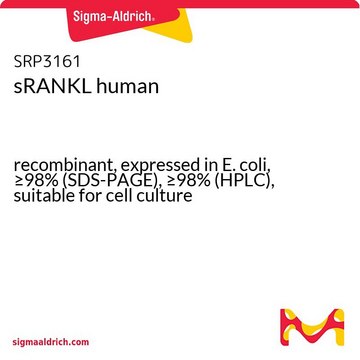T3573
RANK Ligand/TRANCE human
>90% (SDS-PAGE), recombinant, expressed in NSO cells, lyophilized powder
同義詞:
Osteoclast Differentiation Factor (ODF), Osteoprotegerin Ligand (OPGL), Receptor Activator of NF-KB Ligand (RANKL), TNF-related activation-induced cytokines (TRANCE)
登入查看組織和合約定價
全部照片(1)
About This Item
推薦產品
生物源
human
品質等級
重組細胞
expressed in NSO cells
化驗
>90% (SDS-PAGE)
形狀
lyophilized powder
效力
1.5-7.5 ng/mL ED50
分子量
glycolysylated recombinant product ~35 kDa by SDS-PAGE
calculated mol wt 23 kDa
包裝
pkg of 10 μg
儲存條件
avoid repeated freeze/thaw cycles
雜質
endotoxin, tested
UniProt登錄號
應用
cell analysis
儲存溫度
−20°C
基因資訊
human ... TNFSF11(8600)
一般說明
Tumor necrosis factor (ligand) superfamily, member 11 (Tnfsf11) is also known as receptor activator of nuclear factor-κB ligand (RANKL). It is a type II transmembrane signaling receptor. It has a molecular weight of around 35kDa. This protein contains an amino-terminal intracellular tail and a carboxy-terminal extracellular region, that bears a connecting stalk and a receptor-binding domain. Tnfsf11 is located on human chromosome 13q14.11.
應用
RANK Ligand/TRANCE human can be used in in vitro osteoclastogenic assays for osteoclast differentiation.
RANK Ligand/TRANCE human has been used to stimulate differentiation.
生化/生理作用
Member of the TNF superfamily; induces activation of the c-jun N-terminal kinase, enhances T-cell growth and dendritic cell function, induces osteoclastogenesis, and lymph node organogenesis; cell surface receptor for RANK Ligand.
RANK Ligand (receptor activator of NF-kB ligand (RANKL) also referred to as TNF-related activation induced cytokines (TRANCE) or osteoprotegerin ligand is a protein that belongs to tumor necrosis factor (TNF) family. It stimulates the mature dendritic cells and induces the cytokine production. RANKL also facilitates bone remodelling and possess an angiogenic activity.
RANK Ligand/TRANCE, a member of the TNF superfamily, induces activation of the c-jun N-terminal kinase, enhances T-cell growth and dendritic cell function, induces osteoclastogenesis, and lymph node organogenesis. Mouse and human RANK Ligand share 85% amino acid identity. RANK is the cell surface receptor for RANK Ligand.
外觀
Lyophilized from a 0.2 μm filtered solution in 20 mM MOPS and 500 mM NaCl, pH 6.5, with 50 μg BSA per 1 μg as a carrier protein.
分析報告
The biological activity is measured by its ability to induce osteoclast differentiation on mouse splenocytes.
儲存類別代碼
11 - Combustible Solids
水污染物質分類(WGK)
WGK 3
閃點(°F)
Not applicable
閃點(°C)
Not applicable
個人防護裝備
Eyeshields, Gloves, type N95 (US)
RANKL employs distinct binding modes to engage RANK and the osteoprotegerin decoy receptor
Nelson C A, et al.
Structure, 20(11), 1971-1982 (2012)
Matrine prevents bone loss in ovariectomized mice by inhibiting RANKL-induced osteoclastogenesis
Chen X, et al.
Faseb Journal, 31(11), 4855-4865 (2017)
Jeong-Ki Min et al.
The Journal of biological chemistry, 278(41), 39548-39557 (2003-08-02)
Vascular endothelial growth factor (VEGF) is known as a key regulator of angiogenesis during endochondral bone formation. Recently, we demonstrated that TNF-related activation-induced cytokine (TRANCE or RANKL), which is essential for bone remodeling, also had an angiogenic activity. Here we
Cytosolic phospholipase A2 and eicosanoids modulate life, death and function of human osteoclasts in vitro
Allard-Chamard H, et al.
Prostaglandins, Leukotrienes, and Essential Fatty Acids, 90(4), 117-123 (2014)
R Josien et al.
Journal of immunology (Baltimore, Md. : 1950), 162(5), 2562-2568 (1999-03-11)
TNF-related activation-induced cytokine (TRANCE) is a member of the TNF family recently identified in activated T cells. We report here that TRANCE mRNA is constitutively expressed in memory, but not naive, T cells and in single-positive thymocytes. Upon TCR/CD3 stimulation
我們的科學家團隊在所有研究領域都有豐富的經驗,包括生命科學、材料科學、化學合成、色譜、分析等.
聯絡技術服務